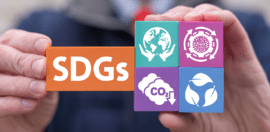SDGs A Powerful Framework For CSR

21 June 2017 at 8:53 am
The Sustainable Development Goals provide a powerful framework for business to engage in corporate social responsibility according to LBG and Corporate Citizenship co-founding director Mike Tuffrey.
The SDGs, officially known as Transforming Our World: The 2030 Agenda for Sustainable Development, are a set of 17 Global Goals, with 169 targets between them, that were adopted by countries around the world in 2015.
Each goal has specific targets to be achieved over 15 years in a bid to end poverty, protect the planet, and ensure prosperity for all.
According to Tuffrey, a global leader in CSR and sustainability, there is both a social expectation and a business opportunity for the corporate world to engage with the goals.
“Our starting point is that businesses are part of society, we call ourselves Corporate Citizenship because we think companies and businesses of all sorts, should behave as though they were citizens of society, the same way as individuals with rights and responsibilities,” Tuffrey told Pro Bono News.
“Obviously they have their job to do, in terms of making goods and services and putting them into the marketplace but the question is if they are to play that wider role, what should they do?”
Tuffrey, a chartered accountant who has experience in the charity sector as well as a public service career in local government and national policy making, said the SDGs were important as it marked the first time the world “as a whole” had come up with a list of priorities.
He said it was significant that business had also had input in shaping the list.
“That is what really makes the Sustainable Development Goals so powerful, is that it is all there. That is the sort of starting point,” he said.
“And business was part of the process for writing them, unlike the Millennium Development Goals, which were the sort of predecessor framework, it wasn’t just governments sitting in New York, sort of saying what needed to be done, there was a big civil society participation in them and for the first time there was serious business participation.”
But according to Tuffrey business still needs to make the next step to move from commitment to action on the SDGs.
“Their strength is their weakness,” he said.
“It is a framework that applies everywhere and to everyone about, if you like, everything. And therefore, how on earth do you swallow that elephant.”
He said there was a danger of cherry picking.
“Certainly we’ve seen some companies, in a way that can be a bit self-regarding, in other words they have looked at their business, and said: ‘This is the important one in our sector and so we’re going to concentrate on that one’. And the danger with that approach is that it stops there.
“It is almost ‘look at us, we’re playing our part’.
“What they’ve done is mapped their own business interests against the goals, found the touch points and then sort of started communicating how they’re doing stuff in that space. But what we… would say is: ‘Okay, there are some goals which are in the 17 where actually you are not doing something’.”
Tuffrey said he liked to cite gender diversity as an example where organisations could be engaging more.
“I really love that one, because it is the only one [goal] that is focused on what one might call a demographic – there is not one about youth, there is not one about disabled people, there is not one about ageing citizens, that’s the only one that is for a demographic. Of all of the issues, if you address discrimination and disadvantage you actually achieve the others,” he said.
“So for example with agricultural productivity, there is very clear evidence that if you are trying to boost productivity and thus farmer income and thus village prosperity and family prosperity, particularly in smallholder farm type places, that actually if you equip the women with the training, the capital, the advice, you get a much bigger uplift in productivity. And not to put too finer point on it, the money stays within the family unit, the men tend to go off and drink it or whatever.
“Going back to my point, a lot of companies say: ‘We don’t have a particular gender focus, we serve everybody’. But actually there is almost certainly for everybody a gender issue, if you look internally at management.”
Tuffrey said once companies had mapped out the obvious touch points with the goals, the next stage was to ask themselves “searching questions” about the other goals.
“Then you have got a complete map,” he said.
“You have got a map of the strong points and the weak points and then what companies need to do is show how they are going to address them all, albeit in different ways. That’s the sort of starting point.
“Then you get onto things like setting targets. Because behind the 17 goals there are 169 individual targets.”
Tuffrey said using the SDGs as a framework “absolutely makes sense” for business that have a desire to play a wider role.
But he said there was also a strong business case to be made for organisations that were not as “socially minded”.
“I think the business case is if these are the goals and other companies and particular governments are saying this is what we need to do, it provides a kind of business framework because companies can see growing opportunities,” he said.
“On energy as it were, on climate change, there is a worldwide move to tackling climate threatening emissions, carbon emissions, and business can expect that particularly over time will, polluting sorts of energy will get more expensive. And likewise on all these responsible consumption production, which is goal 12, they can expect government programs, they can expect big businesses to put things into their contracting for small business, so over time this becomes the framework that companies have to do business within. That is point one. If they are not going in this direction, they can expect things to get more expensive and more difficult because of government regulations and because of contract conditions with big firms.
“The flip side of that is what are the opportunities? So if we are trying to get into renewable energy as a whole, if we’re trying to for example on the water one move towards water efficiency, then there ought to be business opportunities. So for a company with a new water saving device, or ideas for that, it would be worth putting investment in areas that are likely to be in demand over the next kind of 15 years.”
Tuffrey said overall he was optimistic about the potential for businesses to interact with the SDGs.
“Having been critical earlier in our conversation and saying that companies are a bit in danger of just mapping and saying look at all the good things we’re doing, I think what I’m most optimistic about is that it then allows the dialogue to continue and indeed to grow,” he said.
“Currently, civil society, governments, campaigners, charities, individual citizens, can say to companies, look there are these Sustainable Development Goals, the whole world has signed up for them, what are you doing?
“And then when the companies respond, albeit sometimes in a limited way, that then provides a platform for a dialogue.
“So I think what I’m most optimistic about, perversely is the process, the dialogue, the challenge rather than any particular outcome. I have my favourites among them, and I’ve mentioned gender, and poverty, but I am not pinning my hopes to ‘yes by 2030 we will have eliminated poverty everywhere’, I think is much more about the journey that people are on and the SGDs give that framework to have that dialogue. So let the discussion commence.”







